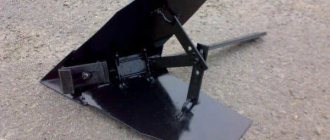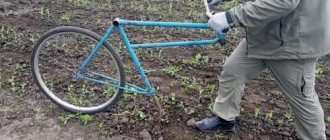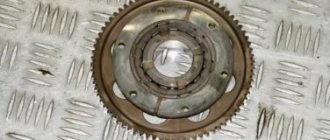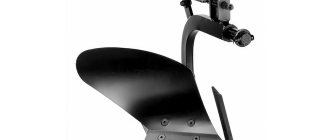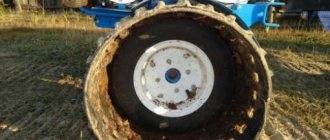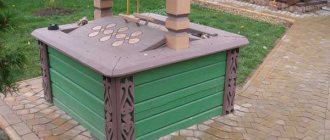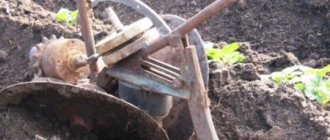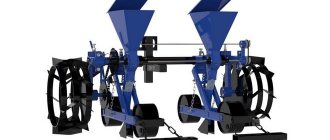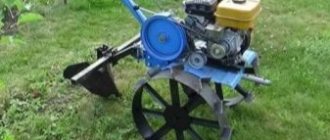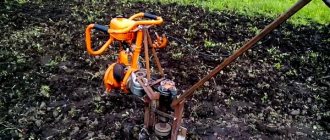Technical characteristics of popular models of hillers
Double-row hiller OH-2: weight – 4.4 kg.
Dimensions – 450x130x45 mm, working width – 300 mm. It is hung directly on the frame of the Neva walk-behind tractor. Sliding disk hiller: maximum working width – 700 mm, disc diameter – 370 mm, total equipment height – 625 mm, maximum bed height – 30 cm. This model has the ability to adjust the discs in width, depth and height. For aggregation with the Neva walk-behind tractor, a universal hitch is needed.
There are many other models that can also be used to work with the Neva walk-behind tractor - the main thing is that the fastening mechanism matches this particular brand of walk-behind tractor. And the simplicity of the hiller design allows you, taking the factory version as a model, to easily make it yourself. But this is a topic for another discussion.
An example of self-made lister hiller
As you can see, hillers are fairly simple designs. There is nothing complicated about making a hiller with your own hands for a walk-behind tractor.
To create a traditional non-adjustable hiller, you need to cut out halves of the product using a template from metal 2 mm thick
These halves should be bent until the radii match, and then welded in 2-3 passes. Weld seams should be processed with a grinder and, if necessary, selectively welded and re-cleaned. The result should be a perfect, even layer of metal.
The wings of the instrument are also cut from metal 2 mm thick and connected according to the same principle
The result should be a design like this. For clarity, the thickness of the elements and all dimensions of the tool base are indicated.
Hilling
If you decide to hill potatoes with a Neva motor-cultivator, then you need to take care of the correct planting of the material, since the procedure can only be carried out with this device with a distance between rows of 70 centimeters.
Disk
Externally, the device looks like a two-wheeled frame with disks. The device includes the following parts:
- disks – 2 pieces;
- screw lanyards – 2 pieces;
- racks - two pieces;
- T-shaped leash.
Stands are needed to measure the distance between disks. Due to this, you have the opportunity to set the optimal distance, which depends on the crop variety.
Turnbuckles regulate the angle of rotation of these discs.
The rotation angle can be adjusted manually
The disc hiller has the following advantages:
- smooth and high ridges;
- good soil looseness;
- efficiency in energy consumption;
- ease of operation.
With this device, hilling is carried out quickly and the quality is achieved precisely due to the discs, which evenly cover the potatoes with soil on both sides.
The only drawback of the device is the high price.
Double row plow
Before hilling potatoes using a Neva walk-behind tractor and a two-row plow-shaped hiller, you should perform some preparatory steps. First you need to select a trailer. To carry out the procedure, experts recommend using special structures, not those intended for plowing the soil. Such devices generally have a large diameter. This is necessary to ensure protection of the bushes from crushing, since small soil trailers will not be able to sufficiently protect the bushes from the motor cultivator, and the potatoes may be damaged.
After selecting a device, it must be installed on the implement and the width must be adjusted. The adjustment is made in such a way that the hiller falls in the middle of the row. Next, adjust the processing depth. To do this, the device is immersed in the ground to the required depth and the axis is set perpendicular to the ground.
When the settings are completed, we proceed to hilling. In one pass, the device makes trenches on both sides of the row, as well as for the adjacent one. Therefore, the next approach is performed through a row. This feature allows you to save a lot of time during processing.
Single row plow
When hilling potatoes using a Neva walk-behind tractor with a single-row plow-shaped hiller, soil trailers with a smaller diameter are used. Using such a device, trenches are created between two rows, and if this distance is too large, then it is necessary to make more row spacing. If you choose the right soil trailer, hilling will be carried out immediately between two furrows, on both sides.
After completing the installation, it is necessary, as in the previous case, to adjust the processing depth. Next, we simply run the cultivator along one row, then move on to the next.
This device is less efficient compared to a two-row hiller, but it greatly simplifies the procedure compared to manual labor.
The main advantage of the device is saving time, effort and energy. It also costs much less than the previous type.
How to install a hiller on a walk-behind tractor?
Since recently agronomists are increasingly using a two-row hiller, we should consider the specifics of installing a hitch of this particular type. Often, fixation occurs through the use of special couplings SV-2 and SV-1/1. A prerequisite for proper installation is the presence of lugs, the diameter of which should not be less than 600 mm. Otherwise, it will be impossible to avoid squeezing the potato tops by the reducer.
It is important to direct the hiller correctly, because you can get the desired result only if it is oriented parallel to the ground surface. This can be done simply by just adjusting a few bolts on the bracket
During the process, special attention should be paid to selecting the width of the furrow and the depth of immersion in the ground, because after processing the ridges should be at the same level. This depth is adjusted in several ways:
Important Technical characteristics of the European standard of Italian chainsaws Alpina
- The master should be guided by the height of the mounting holes;
- The presence of a screw adjustment (for adjustable objects) will allow you to change the angle between the nozzle frame and the unit itself while turning the handle.
To adjust the width of the furrows, you should use the frame fastening brackets (move them or spread them apart). You can also follow the directions described in the following videos:
User manual
With the help of a walk-behind tractor and hiller, the grown crop is planted, loosened and hilled. The operating principle of potato harvesting equipment is based on uprooting the root crop from the soil and simultaneously sifting the soil. Vegetables are harvested manually. Hilling of potatoes is carried out in one row. In this case, you can use vibrating equipment of the KKM-1 class, used on soils with low humidity. The soil itself should not contain more than 9 t/ha of stones. Let's take a closer look at the full operating principle of the hiller. There are several methods for preparing a site before planting potatoes. For this purpose, adjustable type equipment and a mounted potato planter are used.
Method No. 1
Planting a crop is done as follows:
- lug wheels and a disc hiller are attached to the walk-behind tractor, and symmetrical furrows are formed;
- Root crops are manually planted in prepared holes;
- The wheels are replaced with standard rubber ones, their width is adjusted, it should be equal to the track width;
- soft rubber does not damage the structure of the root crop and makes it easy to fill and compact holes with vegetables.
Method No. 2
Planting a crop using a walk-behind tractor with attachments. This method is used on large cultivated areas. Before starting work, it is necessary to prepare the site in advance: plow the ground, create furrows and ridges, moisten the soil. A potato planter is put on the walk-behind tractor, the hiller settings are adjusted and the potatoes are simultaneously planted, furrows are created and the crop is covered with soil.
After several weeks, when seedlings appear, the soil on the site is loosened with a walk-behind tractor and pedestrian rows are created between the bushes. Hilling delivers oxygen and additional moisture to the plant stems, which have a beneficial effect on the growth and development of potatoes. Weeds are being uprooted. For these procedures, a two-, three-, or single hiller is used. During the work, fertilizers are added to the soil. The hiller also performs temporary weeding of the soil between the rows of the crop. When the potatoes are ripe, the standard work of uprooting the potatoes and harvesting is carried out using a special hiller with ploughshares.
For a review of the Neva walk-behind tractor with a disc hiller, see the following video.
Let's block ads! (Why?)
Types of hillers
Hiller is a special equipment that is designed for cultivating soil furrows. The essence of its work is that the earth is evenly distributed on both sides of the furrow. Thus, the summer resident has the opportunity to carry out the procedure much faster. Another advantage of the design is that you can make it yourself.
There are several types of hillers for the Neva walk-behind tractor: disk, rotary, double-row. Let's look at each type in more detail.
Disk
The disc hiller for the Neva walk-behind tractor is similar in principle to the double-row hiller. The main parameters in it are adjusting the distance between the disks and the angle of attack.
In this video you will learn how to hill this walk-behind tractor:
Regulation of the last parameter is required to ensure high-quality processing of row spacing. This device is designed for hilling one row of potatoes, and not two, like the previous one. As a result, the work will take longer to complete. However, the design has its advantages: higher processing efficiency.
When working with such a device, the following rules should be followed:
- The procedure is carried out on damp soil.
- Weeds must be removed before surgery.
- The distance between rows of potatoes should be more than 70 centimeters.
- Work must be carried out at first speed.
- The depths of the disc hiller for the Neva walk-behind tractor need to be adjusted so that the provided coupling design allows increasing the efficiency of processing.
- It is better to do the work measuredly, otherwise the bushes may be damaged.
Rotary
Such devices use two types of forces - rotation and translational motion. A rotary hiller requires the walk-behind tractor to have two gears and a power take-off shaft. The quality of processing is much higher than other types, but it also costs more.
This model can also be made independently. For this you need only high-quality metal. Assembling such a hiller on a Neva walk-behind tractor involves welding the parts using arc welding and adjusting the corresponding parameters.
The main advantage of the device is its versatility. During the operation, the row spacing is not only loosened, but also part of this soil is moved to another row.
Double row
When using a two-row hiller, you will need to place the special hilling lugs of the Neva walk-behind tractor on the extension. The diameter must be large, which is necessary for processing bushes. Otherwise, when working, the walk-behind tractor will crush the bushes under itself.
When the lugs are installed, the next step is to adjust the hiller on the Neva walk-behind tractor according to the processing width, each device should be located in the middle of the row spacing. Then the structure is buried to the required depth and the axis is fixed perpendicular to the ground. This trick allows you to hill up unwanted vegetation with the highest quality.
Don't forget to adjust the incline level
Now you can proceed directly to the procedure. The bushes must be processed one by one, going through all the rows. As you carry out the work, you will end up with furrows on both sides of the row you are going through, and one furrow on the side of the adjacent one. The next gap is processed on one side only.
How to make it yourself
Most often, craftsmen make their own disc types of hillers. In this case, the main structural element is a pair of steel disks of a specific concave shape, which are installed at an angle to each other. Disc-type hillers can be made with either an adjustable distance between the disks or a fixed one. It is clear that the first option is more convenient, but the second one is easier to manufacture.
Before you begin manufacturing the hiller parts, you must first make a detailed drawing of the future device. You can take ready-made diagrams from the Internet for this. It will be useful for all gardeners to understand how to destroy weeds in the garden using folk remedies.
On the video - how to make a potato hiller with your own hands:
Materials and tools
To make a hiller with your own hands you will need the following items:
- A gas cutter for cutting out parts from sheet steel.
- Welding for fastening parts.
- A gas burner to raise the temperature of metal parts before bending them.
- Plumber's tools will also come in handy: especially a vice.
- High power drill and a set of metal drills for it.
- Grinder for cleaning welds and for sharpening blades.
If you decide to make the device yourself, then in this case it will be important to comply with several requirements. We will tell you about the manufacturing stages and necessary requirements in more detail.
The design is simple - it is, in fact, two connected steel disks. The diameter of the discs can be from 370 to 700 mm, their edges must be pointed. The steel sheet for their manufacture must be at least 2 mm thick. You can fasten the discs using welded bushings. And if you weld special hubs to the disks, in which a pair of bearings are provided, then in this case you can achieve free rotation of the disks.
Two concave disks can also be borrowed from an old seeder, if available. And in addition to welding fastening, the disks can be attached to each other with bolts. The discs should deviate outward.
To adjust the length of the top post, you need to drill small holes along its edges and adjust accordingly. It should be borne in mind that the front and rear links of the hiller must be the same in width.
To make cutting discs, use high-density steel sheet. First you need to cut out just a circle, and then give these blanks the desired shape. Outwardly, they should look like discs from a regular plow, which are capable of quickly and deftly turning over layers of earth. When welding the blades to the stand, make sure that the welds are as smooth and straight as possible.
Important Important advantages of using a mini-chainsaw in farming and tourism
The edges of the blades must be sharpened with a grinder so that they can cut the ground without effort. Experts do not recommend purchasing ready-made wheels for a homemade hiller, as in this case it will be difficult to sharpen them. Accordingly, all work will slow down and become more complicated.
If you plan to install the unit on a walk-behind tractor, the device will need to be equipped with a clutch unit during assembly
It is important to make this unit as strong as possible and carefully weld it to the hiller. Maybe
Why do you need a hiller for a walk-behind tractor?
This element is used for planting and caring for vegetables. It works quite simply: after installing the add-on and starting the walk-behind tractor, the part tows the machine across the treated area with planted seeds, thereby sprinkling future vegetation with the necessary layer of moist and slightly loose soil
Such an operation is of considerable importance, because it allows you to protect the seeds from negative atmospheric influences, increase the level of oxygen saturation, and stimulate growth
Experts note that hilling with a walk-behind tractor also helps rid the soil of excess moisture to avoid rotting. After treatment, the sun’s rays penetrate the soil much better, and some harmful insects end up on the surface, where birds “remove” them. Some weeds are also destroyed, so basic treatment can be safely considered a partial replacement for the use of herbicides
It is important to note that hillers are most often used for processing potato plantings.
Types of hillers for walk-behind tractors
A hiller for a walk-behind tractor is equipment necessary in agriculture. It is placed in third place in importance after such structures as a plow and a winch. If you learn to manage it well, it will bring a lot of benefits. There are several varieties of hillers and each has its own purpose, operating principle, and device.
Listerny
This is one of the simple designs installed on a walk-behind tractor. Has a fixed working width. The equipment consists of two fixed wings, connected to each other and slightly moved apart. Since the elements are stationary, it is impossible to adjust the working width. Therefore, it is impossible to adjust the equipment to the size of the row spacing.
There are a number of features:
- Products go on sale with a working width of 25-30 cm. This is not the most convenient option for hilling. The standard for the technology of planting and growing potatoes requires a parameter of 50-60 cm.
- According to the configuration, the presence of thin racks is noted that prevent the cultivators from overloading if the device is immersed in dense layered soil.
- Many models have an ergonomic, streamlined shape, which is recognized as an advantage. This way the blades turn out less during operation and do not dry out the soil.
When purchasing equipment, they examine compliance with the declared technical characteristics and GOST standards.
Disk
Even if you look at the photo you can see a number of advantages. Tool matches tool. Suitable for use on cultivators at low speed. As it increases, the output power also increases. This affects the efficiency of plowing and the duration of work on the site.
High ease of use:
- It doesn't require much effort.
- The structure will gradually move forward, without additional pushing from behind.
Versatility and wide range of applications. The tool is suitable for planting tubers, processing growing potato bushes and other crops during active growth of the above-ground part.
On a note! Models that are manufactured using high-alloy steel with additional rolling bearings are popular. They replaced sliding bushings and have a large diameter.
Propeller
The type of hiller is suitable for equipping a motor cultivator or walk-behind tractor. It has two forward gears. This helps increase power to 180 rpm, provided that the vehicle is driving in second gear. The tool is intended for:
- loosening;
- transferring soil into the bed from the area between the rows.
The unit is really useful, but only if you follow the instructions for installation, subsequent operation, and maintenance.
Variety of choices
A walk-behind tractor or cultivator will help make planting and caring for potatoes easier. When working in the garden or vegetable garden, they are considered indispensable assistants. An integral part of the walk-behind tractor is the plow. It can be revolving and disk. An additional accessory to the technique is a hiller, which can be of several types. https://www.youtube.com/watch?v=IwXYxv73vvc
It will not be possible to immediately determine which hiller is better. The choice of hillers is influenced by many factors, including soil characteristics, the size of the land plot, and the financial part of the issue plays not the least role. Therefore, in order to make the right choice, you need to get acquainted with the description of the most common hillers for walk-behind tractors:
- Hillers that do not require independent adjustment of the width between the metal wings. The furrow for all crops will be the same distance, which is not very convenient. These types of structures are convenient to use for a motor cultivator weighing no more than 30 kg. In addition, the device’s stands are thin and not suitable for cultivating hard soil.
- Equipment that involves changing the width between the wings, so the distance between the furrows can be made different. You can also use two units at the same time on one hitch. It is recommended to install it on a walk-behind tractor weighing more than 30 kg.
- The most popular type is the single-row hiller. The device is designed to work with light soil pre-treated with a cultivator. If a single-row plow is used, the lugs are installed close to each other. This is necessary because hilling is carried out one row at a time. There is a more modern two-row hiller for a walk-behind tractor.
- Another device for hilling vegetables is the Dutch hiller. It allows you to adjust the wings not only horizontally, but also vertically.
- The active hiller (rotary) of the propeller version is easy to use. It has a completely different operating principle. The rotary hiller has rotors with parallel teeth instead of wheels. The device can be installed on a walk-behind tractor and cultivator with two forward gears. Propellers mounted on the crossbar are convenient for crushing and loosening the soil, removing weeds with roots and hilling plants.
- The best, judging by the reviews of owners of walk-behind tractors with an additional device, is considered to be a disk hiller for a walk-behind tractor. It consists of a T-shaped leader, screw adjusters, two stands and two disks. The working elements do not look like wings, but like disks. You can change not only the width, but also the angle of inclination. The result is ridges on the treated area of the required height and width.
Description of the potato variety Zhuravinka, cultivation and yieldRead
Before you start working on your plot of land, you need to know about the settings of the selected attachment. Improper use or installation of equipment may result in crop loss and other adverse results.
The preparatory stage is to cultivate the desired area, it is better to loosen the soil. At the same time, you can apply organic or mineral fertilizers. The looser the soil, the easier it will be to make furrows.
Before planting potatoes with a walk-behind tractor, you need to set marks at a distance of about 65 cm. Then, using a walk-behind tractor with a hiller, make furrows and lay out the planting material. After this, the wheels are changed to rubberized ones, and the wings of the potato hiller to the walk-behind tractor are set to the maximum width. The walk-behind tractor is installed between the rows and the plow is driven along the furrow, covering the planted potatoes.
Types of hillers
Let's look at the most popular models of devices.
OND double row
This device is intended for processing prepared soils, such as gardens, greenhouses, and small vegetable gardens. Its maximum working depth is 12 centimeters, and the minimum is 8 centimeters. This parameter can be adjusted. The width of the model’s wings varies between 25-45 centimeters.
This hiller has its pros and cons
The design has the following dimensions (in centimeters):
- length – 72;
- width – 35;
- height – 54.
Its weight is relatively small - 9.5 kilograms.
STV double-row
This model is popular for its versatility. The weight of models of this kind is 10-13 kilograms. The maximum width reaches one meter. The distance between rows can be adjusted within 20-65 centimeters. The maximum processing depth is 15 centimeters.
The main advantage of the design is that each owner can adjust it to their needs.
STV NPD single-row
These models are used to process fields. The average weight of this design is 5 kilograms. The processing width varies between 20-36 centimeters, and the maximum depth can reach 15 centimeters.
By using this technique, you reduce the risk of damage to the bushes.
Nuances of single- and double-row devices
Depending on the variety, models can be single- or double-row. The good thing about attachments of the second type is that in one pass the operator processes two row spacings at once, raking the soil towards the crop and forming furrows.
Essentially, a double row hiller is like a bracket post that attaches to the hitch and has 2 posts with hillers connected to the hitch via bolts.
The single-row option can process only 1 row per pass. In principle, this is convenient, given that the operator has to spend less time monitoring the progress of the work being performed. This way, the position and movement of the unit will be more correct, which will reduce the percentage of damage to the crop during the hilling process.
The auger hiller is considered low-productive and is characterized by a high energy intensity of the technological process of hilling agricultural crops.
As for the Dutch models, their wings are capable of rotating in vertical and horizontal planes. This leads to high-quality cultivation of the land with a reduction in energy costs. These models are affordable for most buyers and work quite well.
